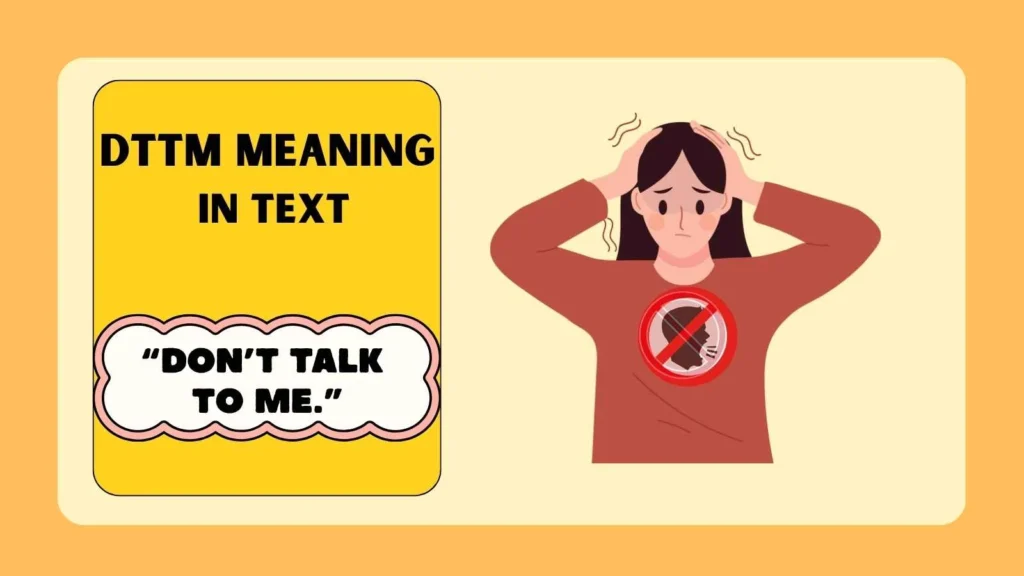Last updated on October 1st, 2025 at 09:25 am
Ever received a message with DTTM and wondered what it means? You’re not alone. In the fast-paced world of texting and social media, acronyms like DTTM pop up everywhere, leaving many people curious.
Whether you’re chatting with friends, navigating dating apps, or scrolling through group chats, this shorthand often sparks questions. Understanding its meaning is essential to avoid confusion and keep conversations flowing smoothly.
This guide explains what DTTM means in text, its origins, common uses, and how to respond. We’ll also explore variations, misconceptions, and when it’s appropriate to use in professional settings.
By the end, you’ll be able to confidently recognize and use DTTM in any digital conversation.
Definition & Meaning
DTTM stands for “Don’t Talk To Me.” It’s a quick, blunt way to signal that someone doesn’t want to chat.
Typically used in texting or social media, DTTM is a straightforward boundary-setting phrase. It can express frustration, a need for space, or a dramatic reaction during a heated conversation.
While it usually carries a negative tone, some people use it jokingly with close friends to tease or playfully shut down a topic.
Background & History
The rise of DTTM can be traced back to the early days of instant messaging and online chatrooms.
As texting became mainstream in the late 2000s, people sought faster ways to communicate emotions.
Acronyms like LOL, BRB, and SMH paved the way for new shorthand expressions, and DTTM gained popularity as a concise way to express boundaries.
Its use exploded with social media platforms like Twitter, Instagram, and TikTok, where quick and impactful phrases dominate.
Usage in Various Contexts
DTTM can appear in different situations depending on the tone of the conversation:
- Serious: Someone upset might text “DTTM” to signal they need space after an argument.
- Playful: Friends jokingly use it when teasing or pretending to be annoyed.
- Flirty: In dating apps, it might be used sarcastically to create playful tension.
- Group Chats: A person may drop DTTM to end an overwhelming conversation thread.
Context and relationship matter. A serious DTTM from a partner differs greatly from a joking one among friends.
Common Misconceptions & Clarifications
Many assume DTTM is always hostile, but that’s not true. It doesn’t necessarily mean permanent disinterest.
Sometimes, it simply signals needing a break. Another misconception is that it’s exclusively for romantic conflicts; in reality, DTTM applies to friendships, work chats, and casual group discussions.
Similar Terms & Alternatives
Several acronyms share a similar vibe:
- STFU (Shut The F* Up):** More aggressive and explicit.
- BRB (Be Right Back): Indicates stepping away, not rejecting conversation.
- IDC (I Don’t Care): Shows indifference rather than avoidance.
- GTG (Got To Go): A polite alternative to exiting a chat.
How to Respond to This Term
Your response depends on context:
- Serious Use: Give space and avoid pushing further.
- Playful Use: Reply with humor, such as an emoji or a funny GIF.
- Unclear Context: Ask politely, “Everything okay?” to check their mood.
Respecting boundaries is key when someone uses DTTM seriously.
Regional or Cultural Differences
While DTTM is widely used in English-speaking countries, its popularity varies. In the U.S. and U.K., it’s common in teen and young adult circles.
Other cultures might prefer local slang or avoid blunt acronyms. In multicultural conversations, always consider if the recipient understands the term before using it.
Comparison with Similar Terms
Unlike IDC (indifference) or GTG (log-off notice), DTTM carries emotional weight. It’s not just about ending a chat—it communicates a desire for distance, whether temporary or permanent.
That makes it stronger than most exit acronyms.
Usage in Online Communities & Dating Apps
On platforms like TikTok, Snapchat, and Bumble, DTTM often appears in memes or captions to signal dramatic humor.
In dating apps, it might be a cheeky way to express fake annoyance or to end a boring conversation.
Tone, emojis, and context help distinguish between flirtation and genuine irritation.
Hidden or Offensive Meanings
While DTTM isn’t inherently offensive, its bluntness can feel harsh if misused.
Overusing it may come off as rude, even when meant playfully. Some might interpret it as rejection or emotional shutdown, so use with caution.
Suitability for Professional Communication
In professional settings, avoid using DTTM. It’s informal and can be seen as unprofessional or disrespectful.
Instead, politely request a pause or reschedule the conversation.
For example: “Let’s revisit this later when we’re both ready to discuss calmly.”
FAQs:
What does DTTM stand for?
It means Don’t Talk To Me, signaling a desire for space.
Is DTTM always serious?
No, it can be playful or sarcastic depending on the context.
Can DTTM be used at work?
No, it’s too informal and can be viewed as unprofessional.
Is DTTM rude?
It can be if used without context or in serious conversations.
What’s a polite alternative?
Try “GTG” (Got To Go) or “BRB” (Be Right Back).
How should I reply to DTTM?
Give space or respond with humor if it’s clearly a joke.
Conclusion:
The acronym DTTM is a powerful, concise way to express boundaries or playful annoyance in digital communication.
Whether it’s a serious request for space or a lighthearted tease, understanding context is key.
By recognizing when and how to use DTTM, you can navigate modern texting culture with confidence and avoid misunderstandings.
